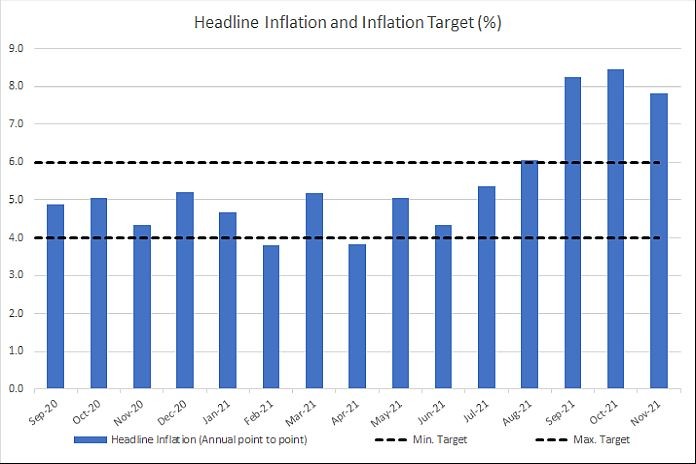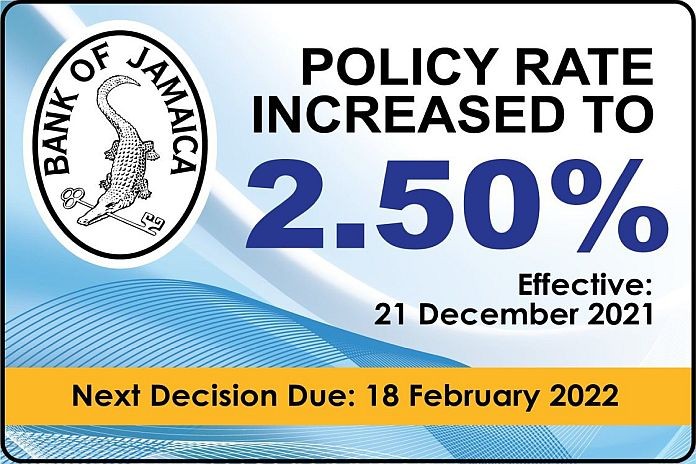KINGSTON, Jamaica – Bank of Jamaica’s Monetary Policy Committee (“MPC/the Committee”) sets monetary policy to meet the inflation target of 4.0 percent – 6.0 percent, as outlined by the minister of finance in April 2021.
At its meetings on 16 and 17 December 2021, the MPC noted that inflation continued to breach the upper limit of the Bank’s target range in November 2021 and would continue to successively breach the target range over the next 8 to 10 months. The Committee noted that while international commodity and shipping prices had declined since its last meeting, past significant increases in these prices have had a stronger than projected pass-through to local prices. While international commodity prices are projected to continue to decline, they have contributed to a further rise in inflation expectations, which were already elevated.
The MPC noted however that, in the wake of its monetary policy adjustments, interest rates in the money market have increased, overnight placements (or liquid balances) by deposit-taking institutions at Bank of Jamaica have declined and deposit rates have started to rise. Further, the indications from the Bank of Jamaica’s credit conditions survey are that deposit-taking institutions plan to increase interest rates on loans, albeit marginally.
In order to limit the second-round effects of the shocks and to guide inflation back within the target range over the next two years, the MPC unanimously agreed to further reduce the level of monetary policy accommodation by increasing the policy rate by 50 bps to 2.50 percent. This decision does not entirely reverse the Bank’s very accommodative monetary policy stance which has prevailed since August 2019 as the real rate of interest on the Bank’s policy instrument remains negative. The Committee also decided to maintain other measures to contain Jamaican dollar liquidity expansion. The Committee reiterated that, while the bank does not target any specific level of the exchange rate, Bank of Jamaica will continue to ensure that further movements in the exchange rate do not threaten the inflation target.
Finally, consistent with meeting its inflation target sustainably in the medium term, the MPC agreed to consider further increases in the bank’s policy rate and accompanying measures at subsequent policy meetings. This position is subject to inflation expectations and other macroeconomic data evolving as projected.
The following considerations informed the Committee’s decisions:
- The annual point-to-point inflation rate at November 2021 was 7.8 percent, below the bank’s forecast and the October 2021 outturn of 8.5 percent but was above the bank’s target range (see chart below).The deceleration in inflation reflected the effects of lower prices for agricultural commodities, consequent on an improvement in supplies. On a monthly basis, however, there were increases in all other divisions of the consumer price index (CPI). In this context, core inflation (defined as the CPI excluding agriculture and fuel prices) at November 2021 accelerated to 8.4 percent from 7.7 percent in October.

- The private sector’s expectation of inflation remains elevated and continues to increase.In the October 2021 survey, respondents indicated that they expect inflation over the ensuing twelve months to be 8.2 percent, significantly above the bank’s inflation target and above the expectations of 7.4 percent reported in the previous two surveys. This increase in expectations is in contrast to the Bank’s objective of returning inflation to the target range by the second half of 2022.
- Bank of Jamaica had projected inflation to average 5½ to 6½ percent over the next two years, which was higher when compared to the average inflation rate of 5.0 percent over the past two years.Inflation was projected to successively breach the upper limit of the bank’s target range over the next 10 – 12 months. Conditional on the gradual tightening of monetary conditions, inflation was projected to return to the bank’s target range of 4.0 to 6.0 per cent by the September 2022 quarter.
- The risks to this inflation forecast are assessed to be skewed to the upside.Upside risks (which means that inflation could track above the forecast) include further increases in inflation expectations, stronger pass-through of international commodity and shipping prices to domestic prices, higher inflation among Jamaica’s main trading partners and the impact of adverse weather on agricultural food prices. One indicator of the higher pass-through from international commodity prices to local prices is the acceleration in the annual change in the Jamaican Producer Price Index (PPI) for manufacturing. At October 2021, the manufacturing PPI rose by 19.1 percent relative to October 2020, from 15.8 percent as at September 2021. Downside risks (which means that inflation could track below the forecast) include lower energy-related prices and lower domestic demand. Fuel prices trended below the bank’s forecast during November 2021, due to heightened concerns about the spread of the Omicron virus and an appreciation of the US dollar.
- An assessment of the risks to the domestic GDP growth forecast suggests that GDP growth will fall in the range of 7.0 percent to 10.0 percent for FY2021/22.The principal downside risk to domestic GDP growth over the forecast horizon is the continued adverse impact of measures to control the spread of the novel coronavirus on both the global and the Jamaican economy and more severe weather patterns in the context of climate change. However, over the next two quarters, growth in agriculture, forestry & fishing is likely to be higher than anticipated due to the government’s support of the industry.
- GDP growth in the US is likely to be lower than projected mainly due to the measures taken to control the spread of variants of the novel coronavirus as well as constraints posed by the shortage of key raw materials and the impact of higher inflation on real incomes. Notwithstanding, economic activity in the US continues to be aided by the progressive control of the COVID-19 pandemic in the context of vaccine rollouts and the release of pent-up demand.
- Inflation in the US accelerated to 6.8 percent at November 2021 and is projected to remain elevated for some time. Against this background, the MPC noted the pronouncements by the Federal Reserve Board (Fed) on 15 December 2021 to more quickly scale back its bond-buying programme (i.e. reducing its monetary accommodation). The Fed’s projection also indicated that the benchmark federal funds rate will be increased three times in 2022, at a much faster pace than originally projected.
- The domestic fiscal policy stance continues to pose little risk to inflation over the near term.
- The MPC will continue to closely monitor the economic environment and is prepared to take further action at the next MPC meeting to achieve its objective.
Chairman of the MPC, 20 December 2021






